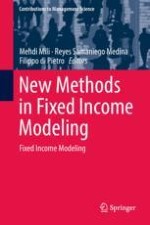
2018 | OriginalPaper | Chapter
Term Structure, Market Expectations of the Short Rate, and Expected Inflation
Authors : Jian Luo, Xiaoxia Ye
Published in: New Methods in Fixed Income Modeling
Publisher: Springer International Publishing
Activate our intelligent search to find suitable subject content or patents.
Select sections of text to find matching patents with Artificial Intelligence. powered by
Select sections of text to find additional relevant content using AI-assisted search. powered by